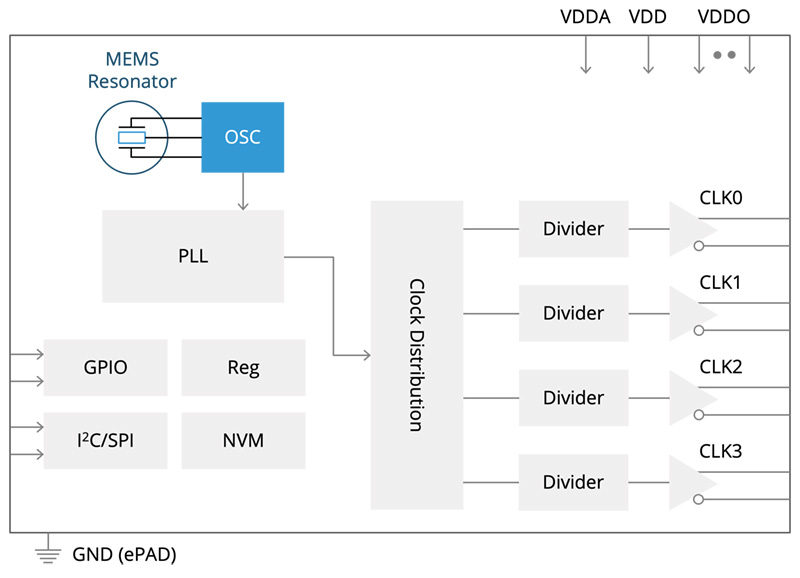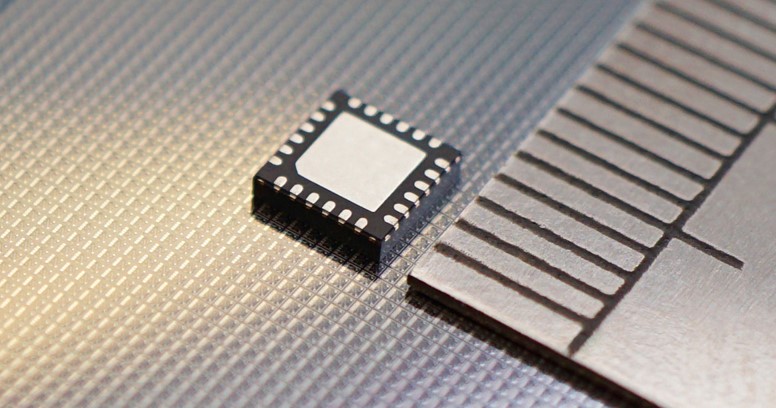Overcoming the Limitations of Traditional Timing Devices
A traditional clock generator uses a quartz-based oscillator or resonator as an input reference for clock generation. By integrating a MEMS resonator, Chorus™ clock generators eliminate the dependency on quartz, along with quartz related performance and reliability issues. Chorus brings the benefits of MEMS and system integration to datacenter, AI, and core/edge/access network applications.
| Device* | Datasheet | # of Differential
Outputs |
# of LVCMOS
Outputs |
Frequency
Stability |
RMS Jitter
(Typ) |
Frequency | Size (QFN) |
|---|---|---|---|---|---|---|---|
| SiT91211 | 4 | 8 | ±20 or ±50 ppm | 150 fs | 1 to 700 MHz | 4 x 4 mm | |
| SiT91213 | 4 | 8 | ±20 or ±50 ppm | 70 fs | 1 to 700 MHz | 4 x 4 mm |
Chorus clock generators are designed for low-power, low-jitter applications. These flexible clocks have configurable output frequency, output buffer types, output skew control, and supply voltage, along with other programmable features to meet specific design requirements.
- Low RMS phase jitter: 70 fs or 150 fs typical (12 kHz to 20 MHz)
- Flexible frequency: Programmable frequency from 1 MHz to 700 MHz
- Excellent frequency stability: ±20 ppm and ±50 ppm from -40°C to 105°C
- Flexible supply voltage: Programmable, 1.8V, 2.5V, or 3.3V
- Flexible output types: Up to four differential (LVPECL, LVDS, LPHCSL) or eight LVCMOS outputs, or a combination of each
- Reduced power and simplified circuitry: FlexSwing™ output reduces power consumption and eliminates termination resistors
- EMI reduction: Configurable spread-spectrum clock generation
- Better power supply noise rejection (PSNR): 0.01 ps/mv
- Compliant with the latest PCIe standard: Generation 1 to 6

Chorus MEMS-based clock generators are a complete clock-system-on-a-chip (ClkSoC). Unlike traditional clock devices that depend on quartz as an input reference for clock generation, Chorus clocks incorporate an integrated MEMS resonator. They are optimized for high reliability communications and enterprise applications and extend the benefits of MEMS timing to AI, datacenters, and 400G/800G/1.6TB connectivity (Ethernet, InfiniBand).
Fully Integrated Solution
Chorus clock generators deliver a single-chip solution by combining silicon MEMS resonator and PLL technology. This simplifies system clock architecture, reduces BOM, and accelerates design time by up to six weeks. By integrating SiTime’s proven MEMS resonator technology within the clock IC, the dependency on external quartz crystals is eliminated along with all the issues associated with external crystals such as capacitive mismatch, activity dips, susceptibility to shock, vibration, and EMI. Designers no longer need to worry about multiple design and test cycles to ensure proper quartz oscillator circuit and load capacitance mismatch which can cause inaccuracy in the output frequencies of the clock IC.

Chorus SiT91211/13 clock generator block diagram with integrated MEMS resonator
Key elements of the Chorus clock generator architecture include:
- Integrated MEMS resonators and oscillator circuit
- Completely programmable low-noise PLL
- Four integer dividers generate high-performance, low-jitter outputs
- Programmable, low-skew clock outputs each with its own dedicated power supply (up to 4 differential or 8 single-ended)
- On-chip NVM that enables a high degree of flexibility and supports multiple configurations to address in-situ clock tree changes
- On-chip regulators deliver excellent power supply noise rejection (PSNR) and ensure low jitter even under noisy conditions
- Chip status monitoring of multiple internal parameters through GPIO pins or direct access of internal registers via I2C/SPI
50% Smaller Footprint
Board space is always at a premium as systems pack more and more functionality into smaller spaces. Traditional clock tree designs typically use clock ICs that are driven by an external quartz resonator (crystal) or by discrete oscillators. In contrast, the single-chip Chorus clock generator—with its internal MEMS resonator and oscillator circuit—can either eliminate the need for an external resonator or it can replace up to four oscillators. Its compact 4 mm x 4 mm package can shrink the total clock tree footprint by up to 50%.

Chorus SiT91211/13 Clock Generator in an industry-standard 24-pin 4 mm x 4 mm x 0.5 mm pitch (wettable flank) QFN package
10X Higher Reliability
Traditional clock ICs need quartz crystal resonators as an input clock reference. This dependency causes many system reliability, design, and performance issues. In contrast, Chorus clock generators eliminate the need for quartz crystal references, which are prone to field failures. SiTime's high quality and reliability has been proven over the shipment of more than 3 billion units, with failure rates less than 1 DPPM and MTBF of over 1 billion hours. This reliability is among the best in the semiconductor industry and an order of magnitude better than quartz crystals.
10X More Resilient
Chorus clocks, with their integrated MEMS resonator, address the limitations of legacy clock generators that depend on quartz crystal references. Designing a PCB with an external quartz component exposes sensitive analog nodes that provide a path for EMI and board noise to couple into the oscillation circuit. Proper PCB design must be ensured to minimize such coupling. Chorus clocks, with best-in-class power supply noise rejection of 0.01 ps/mV, eliminate problems such as noise and system performance degradation due to EMI. Additionally, Chorus clocks do not have activity dips (frequency jumps), are virtually immune to mechanical shock and vibration, and are much less vulnerable to board bending.
Key Resources
Chorus Clock Generator FAQs

Chorus Evaluation Board

SiTime Continues to Advance Precision Timing with an Integrated Clock Chip for AI Datacenters

